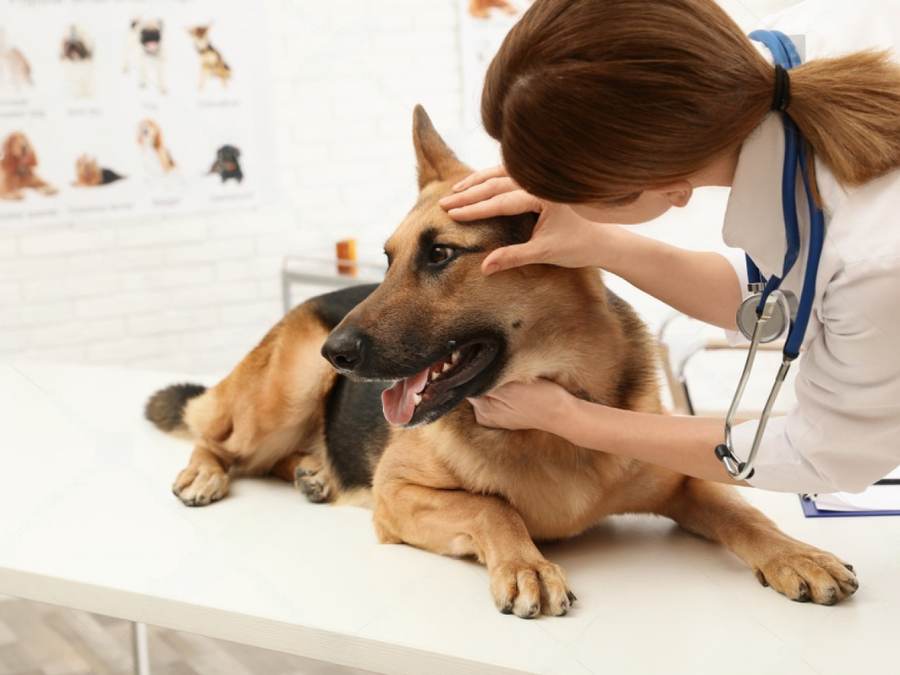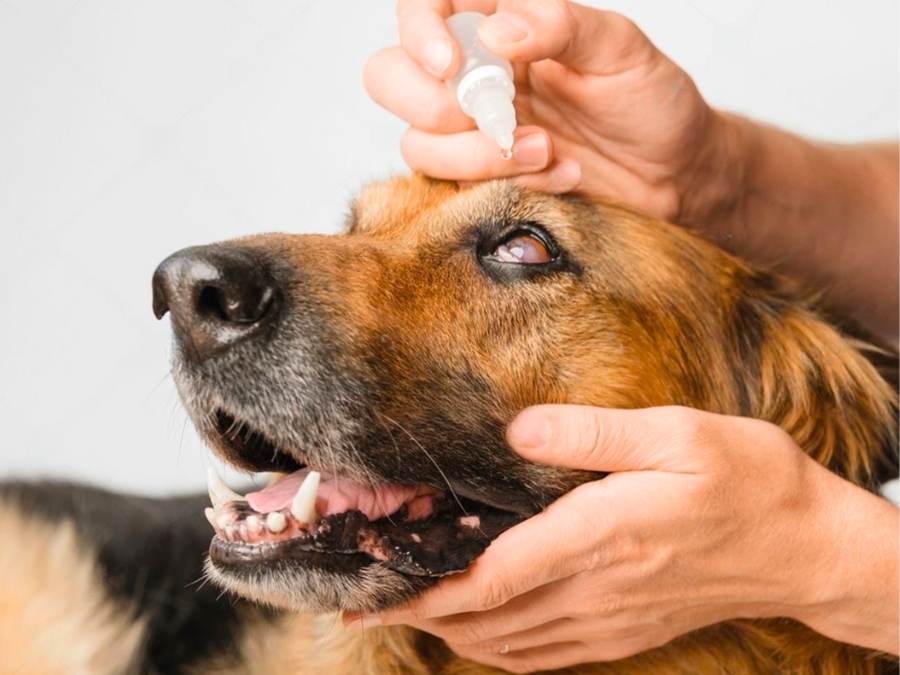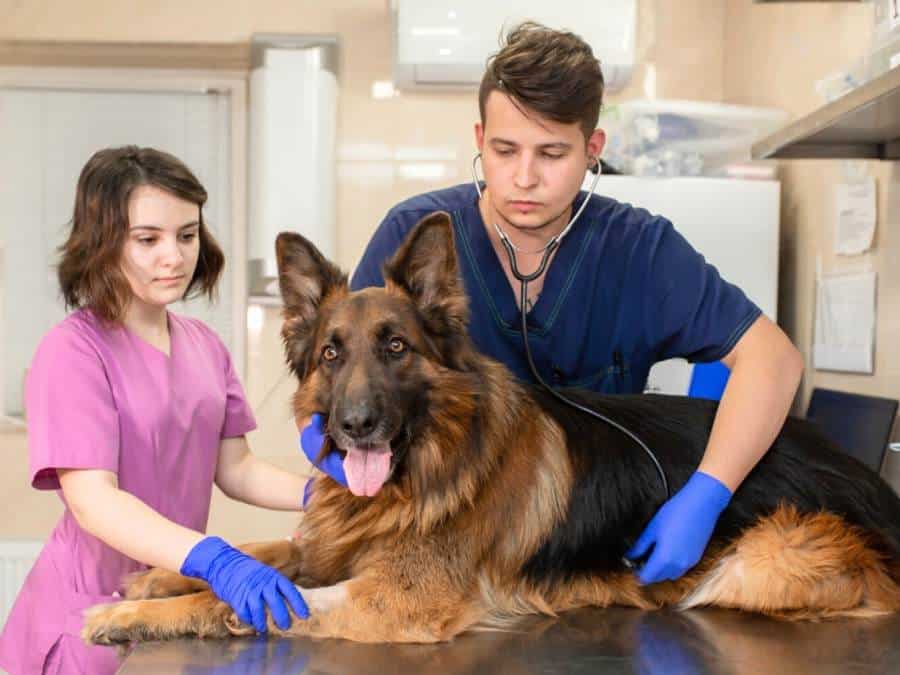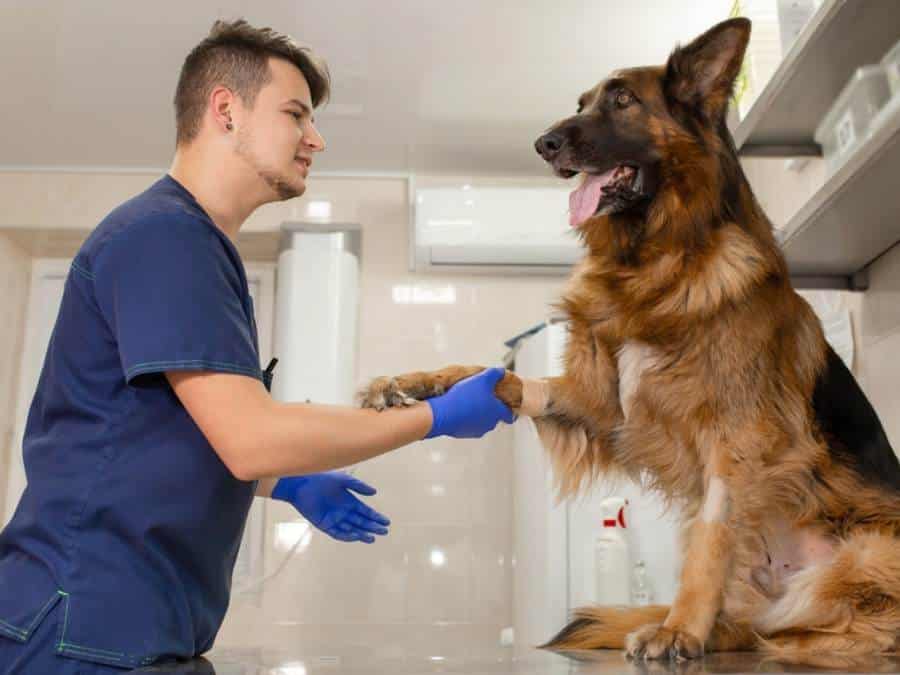German Shepherds, much like humans, can suffer from a variety of eye problems, ranging from minor irritations to serious conditions that can impact their vision. GSD owners like us must be aware of the signs of eye issues, as early detection can often lead to better outcomes.
The most affected parts of a German Shepherd’s eye are the:
- Cornea (the clear part at the front of the eye)
- Eyelids
- Conjunctiva (the moist pink tissue under the eyelid and around the eye)
- Sclera (the white part of the eye)
- Lens (transparent tissue behind the pupil that focuses light)
- Retina (the back of the eye that receives light and sends images to the brain)
This blog post aims to provide an in-depth look at common German Shepherd eye problems, including symptoms, causes, and treatments.
Common German Shepherd Eye Problems
Here are some of the most common eye problems found in German Shepherds:
- Corneal damage
- Dry eye (keratoconjunctivitis sicca)
- Pannus
- Eye Infections
- Pink eye (conjunctivitis)
- Progressive retinal atrophy (PRA)
- Eyelid mass
- Cataracts
- Glaucoma
- Cherry eye
- Entropion
- Ectropion
- Watery Eyes
- Red Eyes
Now let’s discuss each of these GSD eye issues in a bit more detail.
1. Corneal Damage
Corneal damage in German Shepherds can result from trauma, infection, or underlying health issues. Symptoms often include squinting, excessive tearing, redness, and sometimes a visible scratch or ulcer on the eye.
Causes range from physical injury, like running through thick brush, to contact with harmful substances. Treatment typically involves antibiotic or anti-inflammatory eye drops to prevent infection and reduce inflammation.
In severe cases, surgery may be necessary to repair the cornea. Protective eyewear for dogs can help prevent corneal injuries during outdoor activities.
2. Dry Eye (Keratoconjunctivitis Sicca)
Keratoconjunctivitis Sicca, commonly known as dry eye, occurs when German Shepherds produce insufficient tears to keep their eyes moist.
Symptoms include redness, discharge, and a thick, sticky mucus accumulating around the eye. This condition can lead to discomfort, infections, and potentially, vision loss.
Causes range from immune-mediated diseases to side effects of certain medications.
Treatment focuses on increasing tear production and may include tear-stimulating drugs, artificial tears, or surgery in severe cases.
3. Pannus
Pannus, or chronic superficial keratitis, is an autoimmune condition that affects the GSD’s cornea and can lead to blindness if untreated. It’s characterized by the growth of pink, fleshy tissue over the cornea, often accompanied by pigmentation and vascularization.
Symptoms include a visible change in the eye’s appearance and potential vision impairment. Pannus is more common in certain breeds and high-altitude environments.
Treatment involves lifelong management with corticosteroid or immunosuppressive eye drops to slow the progression.
RELATED: German Shepherd Pannus
4. Eye Infections
Eye infections in German Shepherds can be caused by bacteria, viruses, fungi, or irritants like dirt and debris. Common symptoms include redness, swelling, discharge (which may be clear or pus-like), squinting, and rubbing at the eyes.
Some infections, if left untreated, can lead to more serious conditions, such as ulcers or vision loss.
Treatment typically involves topical antibiotics or antifungal medications, and in the case of severe infections, oral medications may also be necessary.
Keeping your German Shepherd’s living area clean and avoiding irritants can help prevent eye infections.
RELATED: German Shepherd Eye Discharge: Abnormal vs Normal
5. Pink Eye (Conjunctivitis)
Conjunctivitis, or pink eye, is the inflammation of the conjunctiva, the tissue lining the eyelids and covering the sclera (the white part of the eye).
This condition can result from allergies, infections, or physical irritants. Symptoms include redness, itching, discharge, and swollen eyelids.
Treatment depends on the underlying cause; it may involve antibiotics for bacterial infections, antihistamines for allergies, or simply cleaning the eye with saline for irritants.
Preventing exposure to allergens and keeping the eyes clean can help reduce the risk of conjunctivitis.
6. Progressive Retinal Atrophy (PRA)
Progressive Retinal Atrophy (PRA) is a group of genetic diseases seen in certain dog breeds such as German Shepherds that leads to the degeneration of the retina, resulting in gradual vision loss and ultimately blindness.
This condition is characterized by the deterioration of both rod and cone cells, which are crucial for night and day vision, respectively.
Symptoms typically start with night blindness; affected German Shepherds may become hesitant to go into dark spaces or become more clumsy in low light.
As PRA progresses, dogs will show a noticeable decline in their ability to see in bright light as well.
There is no cure for PRA, and treatment options are limited to managing the condition and ensuring that the dog’s environment is safe and navigable as their vision declines.
7. Eyelid Mass
Eyelid masses, or tumors, in German Shepherds, can be benign or malignant and may affect the eye’s function and appearance.
Symptoms often include a visible lump on the eyelid, swelling, and sometimes irritation or discharge if the mass rubs against the eye.
Diagnosis typically requires a biopsy to determine the nature of the mass.
Treatment options vary from surgical removal for benign tumors to more aggressive therapies like surgery, radiation, or chemotherapy for malignant ones.
Regular veterinary check-ups can help detect eyelid masses early, improving the outcome.

8. Cataracts
Cataracts in German Shepherds cause opacity in the lens of the eye, leading to a decrease in vision and potentially blindness.
Symptoms include a cloudy or bluish appearance to the eye. Causes range from genetics to diabetes and aging.
Treatment for cataracts usually involves surgical removal of the affected lens, followed by the implantation of an artificial lens to restore vision.
Early detection and management of underlying conditions like diabetes can help prevent the development of cataracts.
9. Glaucoma
Glaucoma is a serious condition in German Shepherds characterized by increased pressure within the eye, leading to pain and potential vision loss.
Symptoms include bulging eyes, cloudiness, tearing, and redness, along with behavioral signs of discomfort or pain.
Glaucoma can be primary (genetic) or secondary to other eye conditions.
Treatment aims to reduce eye pressure and may include medications, laser therapy, or surgery. Early diagnosis and treatment are crucial to prevent irreversible damage to the optic nerve.
10. Cherry Eye
Cherry eye in German Shepherds occurs when the third eyelid’s tear gland prolapses, creating a noticeable red bulge at the eye’s corner.
This condition can lead to dry eye, discomfort, and infections if left untreated. Symptoms include a visible red mass, tearing, and possible irritation.
Cherry eye is more common in younger dogs.
Treatment typically involves surgical repositioning or removal of the gland. Surgery aims to preserve the gland’s function, crucial for adequate tear production.
Post-operative care is important to ensure healing and prevent recurrence.
11. Entropion
Entropion is a condition where a German Shepherd’s eyelid rolls inward, causing eyelashes and skin to rub against the cornea, leading to irritation, ulcers, and potential vision loss.
Symptoms include squinting, tearing, and rubbing at the eyes. Entropion can be congenital or acquired due to age, injury, or infection.
Treatment usually involves surgical correction to reshape the eyelid and prevent further damage to the eye. Early intervention is key to avoiding chronic discomfort and serious complications.
12. Ectropion
Ectropion is the opposite of entropion, with the eyelid rolling outward, exposing the inner eyelid and conjunctiva.
This condition can lead to dryness, irritation, and infections. Symptoms include redness, discharge, and a droopy appearance of the eyelids.
Treatment may include surgical correction, especially if the condition causes significant discomfort or recurrent infections. Moisturizing eye drops can help manage symptoms in mild cases.
13. Watery Eyes
Watery eyes, or epiphora, is a condition characterized by excessive tear production or inadequate drainage, leading to tears spilling over onto the face.
Symptoms include constant tearfulness, stained fur under the eyes, and possibly irritation or skin infection in the affected area.
Causes range from allergies and irritants to more serious issues like blocked tear ducts or eye diseases.
Treatment depends on the underlying cause, from simple cleaning and managing allergies to surgical intervention for blocked ducts. Regular veterinary check-ups can help identify and address the cause of watery eyes.
14. Red Eyes
Red eyes in German Shepherds can signal various conditions, from minor irritations to serious diseases like glaucoma.
Symptoms include redness of the eye or surrounding tissues, often accompanied by discharge, swelling, or squinting.
Causes include infections, allergies, injuries, and systemic diseases. Treatment varies with the underlying cause, emphasizing the importance of veterinary diagnosis.
Managing red eyes may involve antibiotics, anti-inflammatory medications, or more specific treatments for conditions like glaucoma or dry eye.
When to See a Vet
Identifying when your German Shepherd needs veterinary attention for eye problems can be crucial in preventing more serious issues and ensuring the best possible outcome.
Here are key signs and situations when it’s essential to consult a veterinarian:
- Persistent symptoms: If you notice any eye-related symptoms (such as redness, discharge, squinting, or swelling) persisting for more than 24 hours, it’s time to see a vet. Even seemingly minor symptoms can indicate underlying conditions that require professional attention.
- Sudden changes: Any sudden change in the appearance of your German Shepherd’s eyes, such as cloudiness, a visible mass, or a change in eye color, warrants immediate veterinary consultation. These changes can signal serious conditions like cataracts, glaucoma, or tumors.
- Behavioral changes: If your dog is showing signs of discomfort, such as pawing at their eyes, increased blinking, or an aversion to bright light, these could be indicators of pain or discomfort associated with eye issues.
- Vision problems: Signs of vision loss, like bumping into objects, difficulty finding toys, or hesitant behavior in new environments, suggest that your dog may be experiencing significant eye problems that could result in blindness if untreated.
- Pre-existing health conditions: German Shepherds with pre-existing health conditions such as diabetes are at a higher risk for developing eye problems, including cataracts. Regular eye exams are crucial for these pets, and any new symptoms should prompt a vet visit.
- Trauma to the eye: Any injury or trauma to the eye area, no matter how minor it may seem, requires a professional evaluation. Even small scratches can lead to infections or more severe complications.
- No improvement with treatment: If you’ve been treating an eye condition under veterinary guidance but see no improvement (or if the condition worsens), it’s important to follow up. Adjustments to treatment may be necessary.
Remember, timely and appropriate veterinary care is key to managing eye problems in German Shepherds effectively. Always err on the side of caution and consult your vet when in doubt about your dog’s eye health.

German Shepherd Eye Problems Treatment
Treating eye problems in German Shepherds encompasses a wide range of approaches, depending on the specific condition, its severity, and the underlying cause.
Here’s a general overview of treatment options for various German Shepherd eye issues:
- Medications:
- Antibiotics are used to treat bacterial infections, available as eye drops or ointments.
- Steroids may be prescribed to reduce inflammation for conditions like conjunctivitis or uveitis. They must be used under strict veterinary supervision to avoid complications.
- Artificial Tears help manage dry eye (keratoconjunctivitis sicca) by supplementing the eye’s natural moisture.
- Antifungal medications are necessary for fungal eye infections and are typically administered as drops or ointments.
- Surgery:
- Procedures to remove foreign objects or treat injuries can prevent further damage to the eye and alleviate pain.
- Surgical intervention is often required for structural issues like cherry eye, entropion, or ectropion, and for removing tumors.
- Cataract surgery involves removing the cloudy lens and, in some cases, replacing it with an artificial one to restore vision.
- Laser Therapy:
- Used primarily for glaucoma to reduce intraocular pressure and for certain types of tumors.
- Management of Underlying Conditions:
- Diseases like diabetes can lead to eye problems, so managing the primary condition is crucial in these cases.
- Diet and Supplements:
- A balanced diet rich in antioxidants and specific supplements like omega-3 fatty acids can support eye health and may slow the progression of certain degenerative diseases like PRA.
- Protective Eyewear:
- Dogs exposed to harsh environments or bright sunlight may benefit from wearing protective goggles to prevent injuries and UV damage.
- Regular Monitoring and Check-ups:
- Ongoing veterinary care is essential for chronic conditions like glaucoma or PRA to monitor progression and adjust treatment as needed.
Effective treatment of eye problems in German Shepherds requires a comprehensive approach that includes accurate diagnosis, appropriate treatment, and ongoing management. Veterinary professionals are your best resource for ensuring your dog receives the care they need.
Closing Thoughts
Understanding common German Shepherd eye problems is crucial for GSD owners to ensure their furry friends maintain good eye health. Recognizing symptoms early and seeking veterinary care can prevent minor issues from developing into serious conditions. Regular check-ups, proper eye care, and protective measures during outdoor activities can help keep your German Shepherd’s eyes healthy. Always consult a veterinarian if you notice any changes in your dog’s eye health to ensure prompt and appropriate care.
FURTHER READING:




